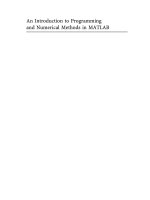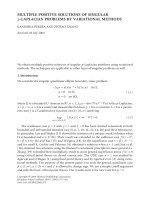- Trang chủ >>
- Sư phạm >>
- Sư phạm toán
Ravi p agarwal, kanishka perera, sandra pinelas (auth ) an introduction to complex analysis springer us (2011)
Bạn đang xem bản rút gọn của tài liệu. Xem và tải ngay bản đầy đủ của tài liệu tại đây (2.65 MB, 346 trang )
An Introduction to Complex Analysis
Ravi P. Agarwal • Kanishka Perera
Sandra Pinelas
An Introduction to Complex
Analysis
Ravi P. Agarwal Kanishka Perera
Department of Mathematics Department of Mathematical Sciences
Florida Institute of Technology Florida Institute of Technology
Melbourne, FL 32901, USA
Melbourne, FL 32901, USA
Sandra Pinelas
Department of Mathematics
Azores University, Apartado 1422
9501-801 Ponta Delgada, Portugal
ISBN 978-1-4614-0194-0 e-ISBN 978-1-4614-0195-7
DOI 10.1007/978-1-4614-0195-7
Springer New York Dordrecht Heidelberg London
Library of Congress Control Number: 2011931536
Mathematics Subject Classification (2010): M12074, M12007
© Springer Science+Business Media, LLC 2011
All rights reserved. This work may not be translated or copied in whole or in part without the written
permission of the publisher (Springer Science+Business Media, LLC, 233 Spring Street, New York,
NY 10013, USA), except for brief excerpts in connection with reviews or scholarly analysis. Use in
connection with any form of information storage and retrieval, electronic adaptation, computer
software, or by similar or dissimilar methodology now known or hereafter developed is forbidden.
The use in this publication of trade names, trademarks, service marks, and similar terms, even if they
are not identified as such, is not to be taken as an expression of opinion as to whether or not they are
subject to proprietary rights.
Printed on acid-free paper
Springer is part of Springer Science+Business Media (www.springer.com)
Dedicated to our mothers:
Godawari Agarwal, Soma Perera, and Maria Pinelas
Preface
Complex analysis is a branch of mathematics that involves functions of
complex numbers. It provides an extremely powerful tool with an unex-
pectedly large number of applications, including in number theory, applied
mathematics, physics, hydrodynamics, thermodynamics, and electrical en-
gineering. Rapid growth in the theory of complex analysis and in its appli-
cations has resulted in continued interest in its study by students in many
disciplines. This has given complex analysis a distinct place in mathematics
curricula all over the world, and it is now being taught at various levels in
almost every institution.
Although several excellent books on complex analysis have been written,
the present rigorous and perspicuous introductory text can be used directly
in class for students of applied sciences. In fact, in an effort to bring the
subject to a wider audience, we provide a compact, but thorough, intro-
duction to the subject in An Introduction to Complex Analysis. This
book is intended for readers who have had a course in calculus, and hence
it can be used for a senior undergraduate course. It should also be suitable
for a beginning graduate course because in undergraduate courses students
do not have any exposure to various intricate concepts, perhaps due to an
inadequate level of mathematical sophistication.
The subject matter has been organized in the form of theorems and
their proofs, and the presentation is rather unconventional. It comprises
50 class tested lectures that we have given mostly to math majors and en-
gineering students at various institutions all over the globe over a period
of almost 40 years. These lectures provide flexibility in the choice of ma-
terial for a particular one-semester course. It is our belief that the content
in a particular lecture, together with the problems therein, provides fairly
adequate coverage of the topic under study.
A brief description of the topics covered in this book follows: In Lec-
ture 1 we first define complex numbers (imaginary numbers) and then for
such numbers introduce basic operations–addition, subtraction, multipli-
cation, division, modulus, and conjugate. We also show how the complex
numbers can be represented on the xy-plane. In Lecture 2, we show that
complex numbers can be viewed as two-dimensional vectors, which leads
to the triangle inequality. We also express complex numbers in polar form.
In Lecture 3, we first show that every complex number can be written
in exponential form and then use this form to raise a rational power to a
given complex number. We also extract roots of a complex number and
prove that complex numbers cannot be totally ordered. In Lecture 4, we
collect some essential definitions about sets in the complex plane. We also
introduce stereographic projection and define the Riemann sphere. This
vii
viii Preface
ensures that in the complex plane there is only one point at infinity.
In Lecture 5, first we introduce a complex-valued function of a com-
plex variable and then for such functions define the concept of limit and
continuity at a point. In Lectures 6 and 7, we define the differentia-
tion of complex functions. This leads to a special class of functions known
as analytic functions. These functions are of great importance in theory
as well as applications, and constitute a major part of complex analysis.
We also develop the Cauchy-Riemann equations, which provide an easier
test to verify the analyticity of a function. We also show that the real
and imaginary parts of an analytic function are solutions of the Laplace
equation.
In Lectures 8 and 9, we define the exponential function, provide some
of its basic properties, and then use it to introduce complex trigonometric
and hyperbolic functions. Next, we define the logarithmic function, study
some of its properties, and then introduce complex powers and inverse
trigonometric functions. In Lectures 10 and 11, we present graphical
representations of some elementary functions. Specially, we study graphical
representations of the Moăbius transformation, the trigonometric mapping
sin z, and the function z1/2.
In Lecture 12, we collect a few items that are used repeatedly in
complex integration. We also state Jordan’s Curve Theorem, which seems
to be quite obvious; however, its proof is rather complicated. In Lecture
13, we introduce integration of complex-valued functions along a directed
contour. We also prove an inequality that plays a fundamental role in our
later lectures. In Lecture 14, we provide conditions on functions so that
their contour integral is independent of the path joining the initial and
terminal points. This result, in particular, helps in computing the contour
integrals rather easily. In Lecture 15, we prove that the integral of an
analytic function over a simple closed contour is zero. This is one of the
fundamental theorems of complex analysis. In Lecture 16, we show that
the integral of a given function along some given path can be replaced by
the integral of the same function along a more amenable path. In Lecture
17, we present Cauchy’s integral formula, which expresses the value of an
analytic function at any point of a domain in terms of the values on the
boundary of this domain. This is the most fundamental theorem of complex
analysis, as it has numerous applications. In Lecture 18, we show that
for an analytic function in a given domain all the derivatives exist and are
analytic. Here we also prove Morera’s Theorem and establish Cauchy’s
inequality for the derivatives, which plays an important role in proving
Liouville’s Theorem.
In Lecture 19, we prove the Fundamental Theorem of Algebra, which
states that every nonconstant polynomial with complex coefficients has at
least one zero. Here, for a given polynomial, we also provide some bounds
Preface ix
on its zeros in terms of the coefficients. In Lecture 20, we prove that a
function analytic in a bounded domain and continuous up to and including
its boundary attains its maximum modulus on the boundary. This result
has direct applications to harmonic functions.
In Lectures 21 and 22, we collect several results for complex sequences
and series of numbers and functions. These results are needed repeatedly
in later lectures. In Lecture 23, we introduce a power series and show
how to compute its radius of convergence. We also show that within its
radius of convergence a power series can be integrated and differentiated
term-by-term. In Lecture 24, we prove Taylor’s Theorem, which expands
a given analytic function in an infinite power series at each of its points
of analyticity. In Lecture 25, we expand a function that is analytic in
an annulus domain. The resulting expansion, known as Laurent’s series,
involves positive as well as negative integral powers of (z − z0). From ap-
plications point of view, such an expansion is very useful. In Lecture 26,
we use Taylor’s series to study zeros of analytic functions. We also show
that the zeros of an analytic function are isolated. In Lecture 27, we in-
troduce a technique known as analytic continuation, whose principal task
is to extend the domain of a given analytic function. In Lecture 28, we
define the concept of symmetry of two points with respect to a line or a
circle. We shall also prove Schwarz’s Reflection Principle, which is of great
practical importance for analytic continuation.
In Lectures 29 and 30, we define, classify, characterize singular points
of complex functions, and study their behavior in the neighborhoods of
singularities. We also discuss zeros and singularities of analytic functions
at infinity.
The value of an iterated integral depends on the order in which the
integration is performed, the difference being called the residue. In Lecture
31, we use Laurent’s expansion to establish Cauchy’s Residue Theorem,
which has far-reaching applications. In particular, integrals that have a
finite number of isolated singularities inside a contour can be integrated
rather easily. In Lectures 32-35, we show how the theory of residues can
be applied to compute certain types of definite as well as improper real
integrals. For this, depending on the complexity of an integrand, one needs
to choose a contour cleverly. In Lecture 36, Cauchy’s Residue Theorem
is further applied to find sums of certain series.
In Lecture 37, we prove three important results, known as the Argu-
ment Principle, Rouch´e’s Theorem, and Hurwitz’s Theorem. We also show
that Rouch´e’s Theorem provides locations of the zeros and poles of mero-
morphic functions. In Lecture 38, we further use Rouch´e’s Theorem to
investigate the behavior of the mapping f generated by an analytic func-
tion w = f (z). Then we study some properties of the inverse mapping f −1.
We also discuss functions that map the boundaries of their domains to the
x Preface
boundaries of their ranges. Such results are very important for constructing
solutions of Laplace’s equation with boundary conditions.
In Lecture 39, we study conformal mappings that have the angle-
preserving property, and in Lecture 40 we employ these mappings to es-
tablish some basic properties of harmonic functions. In Lecture 41, we
provide an explicit formula for the derivative of a conformal mapping that
maps the upper half-plane onto a given bounded or unbounded polygonal
region. The integration of this formula, known as the Schwarz-Christoffel
transformation, is often applied in physical problems such as heat conduc-
tion, fluid mechanics, and electrostatics.
In Lecture 42, we introduce infinite products of complex numbers and
functions and provide necessary and sufficient conditions for their conver-
gence, whereas in Lecture 43 we provide representations of entire functions
as finite/infinite products involving their finite/infinite zeros. In Lecture
44, we construct a meromorphic function in the entire complex plane with
preassigned poles and the corresponding principal parts.
Periodicity of analytic/meromorphic functions is examined in Lecture
45. Here, doubly periodic (elliptic) functions are also introduced. The
Riemann zeta function is one of the most important functions of classical
mathematics, with a variety of applications in analytic number theory. In
Lecture 46, we study some of its elementary properties. Lecture 47 is
devoted to Bieberbach’s conjecture (now theorem), which had been a chal-
lenge to the mathematical community for almost 68 years. A Riemann
surface is an ingenious construct for visualizing a multi-valued function.
These surfaces have proved to be of inestimable value, especially in the
study of algebraic functions. In Lecture 48, we construct Riemann sur-
faces for some simple functions. In Lecture 49, we discuss the geometric
and topological features of the complex plane associated with dynamical
systems, whose evolution is governed by some simple iterative schemes.
This work, initiated by Julia and Mandelbrot, has recently found applica-
tions in physical, engineering, medical, and aesthetic problems; specially
those exhibiting chaotic behavior.
Finally, in Lecture 50, we give a brief history of complex numbers.
The road had been very slippery, full of confusions and superstitions; how-
ever, complex numbers forced their entry into mathematics. In fact, there
is really nothing imaginary about imaginary numbers and complex about
complex numbers.
Two types of problems are included in this book, those that illustrate the
general theory and others designed to fill out text material. The problems
form an integral part of the book, and every reader is urged to attempt
most, if not all of them. For the convenience of the reader, we have provided
answers or hints to all the problems.
Preface xi
In writing a book of this nature, no originality can be claimed, only a
humble attempt has been made to present the subject as simply, clearly, and
accurately as possible. The illustrative examples are usually very simple,
keeping in mind an average student.
It is earnestly hoped that An Introduction to Complex Analysis
will serve an inquisitive reader as a starting point in this rich, vast, and
ever-expanding field of knowledge.
We would like to express our appreciation to Professors Hassan Azad,
Siegfried Carl, Eugene Dshalalow, Mohamed A. El-Gebeily, Kunquan Lan,
Radu Precup, Patricia J.Y. Wong, Agacik Zafer, Yong Zhou, and Changrong
Zhu for their suggestions and criticisms. We also thank Ms. Vaishali Damle
at Springer New York for her support and cooperation.
Ravi P Agarwal
Kanishka Perera
Sandra Pinelas
Contents
Preface vii
1. Complex Numbers I 1
2. Complex Numbers II 6
3. Complex Numbers III 11
4. Set Theory in the Complex Plane 20
5. Complex Functions 28
6. Analytic Functions I 37
7. Analytic Functions II 42
8. Elementary Functions I 52
9. Elementary Functions II 57
10. Mappings by Functions I 64
11. Mappings by Functions II 69
12. Curves, Contours, and Simply Connected Domains 77
13. Complex Integration 83
14. Independence of Path 91
15. Cauchy-Goursat Theorem 96
16. Deformation Theorem 102
17. Cauchy’s Integral Formula 111
18. Cauchy’s Integral Formula for Derivatives 116
19. The Fundamental Theorem of Algebra 125
20. Maximum Modulus Principle 132
21. Sequences and Series of Numbers 138
22. Sequences and Series of Functions 145
23. Power Series 151
24. Taylor’s Series 159
25. Laurent’s Series 169
xiii
xiv Contents
26. Zeros of Analytic Functions 177
27. Analytic Continuation 183
28. Symmetry and Reflection 190
29. Singularities and Poles I 195
30. Singularities and Poles II 200
31. Cauchy’s Residue Theorem 207
32. Evaluation of Real Integrals by Contour Integration I 215
33. Evaluation of Real Integrals by Contour Integration II 220
34. Indented Contour Integrals 229
35. Contour Integrals Involving Multi-valued Functions 235
36. Summation of Series 242
37. Argument Principle and Rouch´e and Hurwitz Theorems 247
38. Behavior of Analytic Mappings 253
39. Conformal Mappings 258
40. Harmonic Functions 267
41. The Schwarz-Christoffel Transformation 275
42. Infinite Products 281
43. Weierstrass’s Factorization Theorem 287
44. Mittag-Leffler Theorem 293
45. Periodic Functions 298
46. The Riemann Zeta Function 303
47. Bieberbach’s Conjecture 308
48. The Riemann Surfaces 312
49. Julia and Mandelbrot Sets 316
50. History of Complex Numbers 321
References for Further Reading 327
Index 329
Lecture 1
Complex Numbers I
We begin this lecture with the definition of complex numbers and then
introduce basic operations-addition, subtraction, multiplication, and divi-
sion of complex numbers. Next, we shall show how the complex numbers
can be represented on the xy-plane. Finally, we shall define the modulus
and conjugate of a complex number.
Throughout these lectures, the following well-known notations will be
used:
IN = {1, 2, · · ·}, the set of all natural numbers;
Z = {· · · , −2, −1, 0, 1, 2, · · ·}, the set of all integers;
Q = {m/n : m, n ∈ Z, n = 0}, the set of all rational numbers;
IR = the set of all real numbers.
A complex number is an expression of the form a + ib, where a and
b ∈ IR, and i (sometimes j) is just a symbol.
C = {a + ib : a, b ∈ IR}, the set of all complex numbers.
It is clear that IN ⊂ Z ⊂ Q ⊂ IR ⊂ C.
For a complex number, z = a + ib, Re(z) = a is the real part of z, and
Im(z) = b is the imaginary part of z. If a = 0, then z is said to be a purely
imaginary number. Two complex numbers, z and w are equal; i.e., z = w,
if and only if, Re(z) = Re(w) and Im(z) = Im(w). Clearly, z = 0 is the
only number that is real as well as purely imaginary.
The following operations are defined on the complex number system:
(i). Addition: (a + bi) + (c + di) = (a + c) + (b + d)i.
(ii). Subtraction: (a + bi) − (c + di) = (a − c) + (b − d)i.
(iii). Multiplication: (a + bi)(c + di) = (ac − bd) + (bc + ad)i.
As in real number system, 0 = 0 + 0i is a complex number such that
z + 0 = z. There is obviously a unique complex number 0 that possesses
this property.
From (iii), it is clear that i2 = −1, and hence, formally, i = √−1. Thus,
except for zero, positive real numbers have real square roots, and negative
real numbers have purely imaginary square roots.
R.P. Agarwal et al., An Introduction to Complex Analysis, 1
DOI 10.1007/978-1-4614-0195-7_1, © Springer Science+Business Media, LLC 2011
2 Lecture 1
For complex numbers z1, z2, z3 we have the following easily verifiable
properties:
(I). Commutativity of addition: z1 + z2 = z2 + z1.
(II). Commutativity of multiplication: z1z2 = z2z1.
(III). Associativity of addition: z1 + (z2 + z3) = (z1 + z2) + z3.
(IV). Associativity of multiplication: z1(z2z3) = (z1z2)z3.
(V). Distributive law: (z1 + z2)z3 = z1z3 + z2z3.
As an illustration, we shall show only (I). Let z1 = a1 +b1i, z2 = a2 +b2i
then
z1 + z2 = (a1 + a2) + (b1 + b2)i = (a2 + a1) + (b2 + b1)i
= (a2 + b2i) + (a1 + b1i) = z2 + z1.
Clearly, C with addition and multiplication forms a field.
We also note that, for any integer k,
i4k = 1, i4k+1 = i, i4k+2 = − 1, i4k+3 = − i.
The rule for division is derived as
a + bi c + di = a + bi c + di · c − di c − di = c2 + d2 ac + bd + c2 + d2 bc − ad i, c2 + d2 = 0.
Example 1.1. Find the quotient (6 + 2i) − (1 + 3i).
−1 + i − 2
(6 + 2i) − (1 + 3i) = 5 − i = (5 − i) (−3 − i)
−1 + i − 2 −3 + i (−3 + i) (−3 − i)
= −15 − 1 − 5i + 3i = − 8 − 1 i.
9+1 55
Geometrically, we can represent complex numbers as points in the xy-
plane by associating to each complex number a + bi the point (a, b) in the
xy-plane (also known as an Argand diagram). The plane is referred to
as the complex plane. The x-axis is called the real axis, and the y-axis is
called the imaginary axis. The number z = 0 corresponds to the origin of
the plane. This establishes a one-to-one correspondence between the set of
all complex numbers and the set of all points in the complex plane.
Complex Numbers I 3
y
2i
· i 2+i
0x
-4 -3 -2 -1 1234
·−3 − 2i -i
-2i
Figure 1.1
We can justify the above representation of complex numbers as follows:
Let A be a point on the real axis such that OA = a. Since i·i a = i2 a = −a,
we can conclude that twice multiplication of the real number a by i amounts
to the rotation of OA through two right angles to the position OA . Thus,
it naturally follows that the multiplication by i is equivalent to the rotation
of OA through one right angle to the position OA . Hence, if y Oy is a
line perpendicular to the real axis x Ox, then all imaginary numbers are
represented by points on y Oy.
y
×A
x × 0× x
A A
y
Figure 1.2
The absolute value or m√odulus of the number z = a√+ ib is√denoted
by |z| and give√n by |z| = a2 + b2. Since a ≤ |a| = a2 ≤ a2 + b2
√
and b ≤ |b| = b2 ≤ a2 + b2, it follows that Re(z) ≤ |Re(z)| ≤ |z| and
Im(z) ≤ |Im(z)| ≤ |z|. Now, let z1 = a1 + b1i and z2 = a2 + b2i then
|z1 − z2| = (a1 − a2)2 + (b1 − b2)2.
Hence, |z1 − z2| is just the distance between the points z1 and z2. This fact
is useful in describing certain curves in the plane.
4 Lecture 1
y
· · |z1 − z2|
z2
|z| z
·z1 x
0
Figure 1.3
Example 1.2. The equation |z − 1 + 3i| = 2 represents the circle whose
center is z0 = 1 − 3i and radius is R = 2.
y
0x
·2
−3i
1 − 3i
Figure 1.4
Example 1.3. The equation |z + 2| = |z − 1| represents the perpendic-
ular bisector of the line segment joining −2 and 1; i.e., the line x = −1/2.
y
|z + 2| |z − 1|
-2 -1 - 1 0 1 x
2
Figure 1.5
Complex Numbers I 5
The complex conjugate of the number z = a + bi is denoted by z and
given by z = a − bi. Geometrically, z is the reflection of the point z about
the real axis.
y
· a + ib
x
0
· a − ib
Figure 1.6
The following relations are immediate:
1. |z1z2| = |z1||z2|, z1 = |z1| , (z2 = 0).
z2 |z2|
2. |z| ≥ 0, and |z| = 0, if and only if z = 0.
3. z = z, if and only if z ∈ IR.
4. z = −z, if and only if z = bi for some b ∈ IR.
5. z1 ± z2 = z1 ± z2.
6. z1z2 = (z1)(z2).
7. z1 = z1 , z2 = 0.
z2 z2
8. Re(z) = z + z , Im(z) = z − z .
2 2i
9. z = z.
10. |z| = |z|, zz = |z|2.
As an illustration, we shall show only relation 6. Let z1 = a1 + b1i, z2 =
a2 + b2i. Then
z1z2 = (a1 + b1i)(a2 + b2i)
= (a1a2 − b1b2) + i(a1b2 + b1a2)
= (a1a2 − b1b2) − i(a1b2 + b1a2)
= (a1 − b1i)(a2 − b2i) = (z1)(z2).









